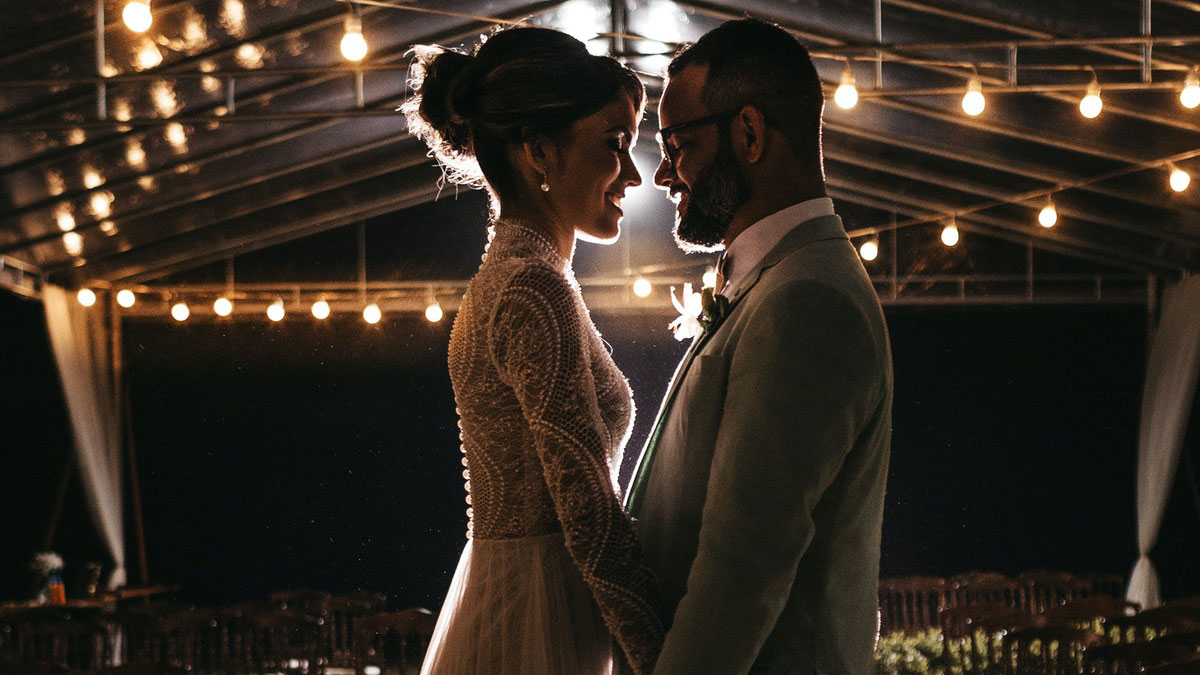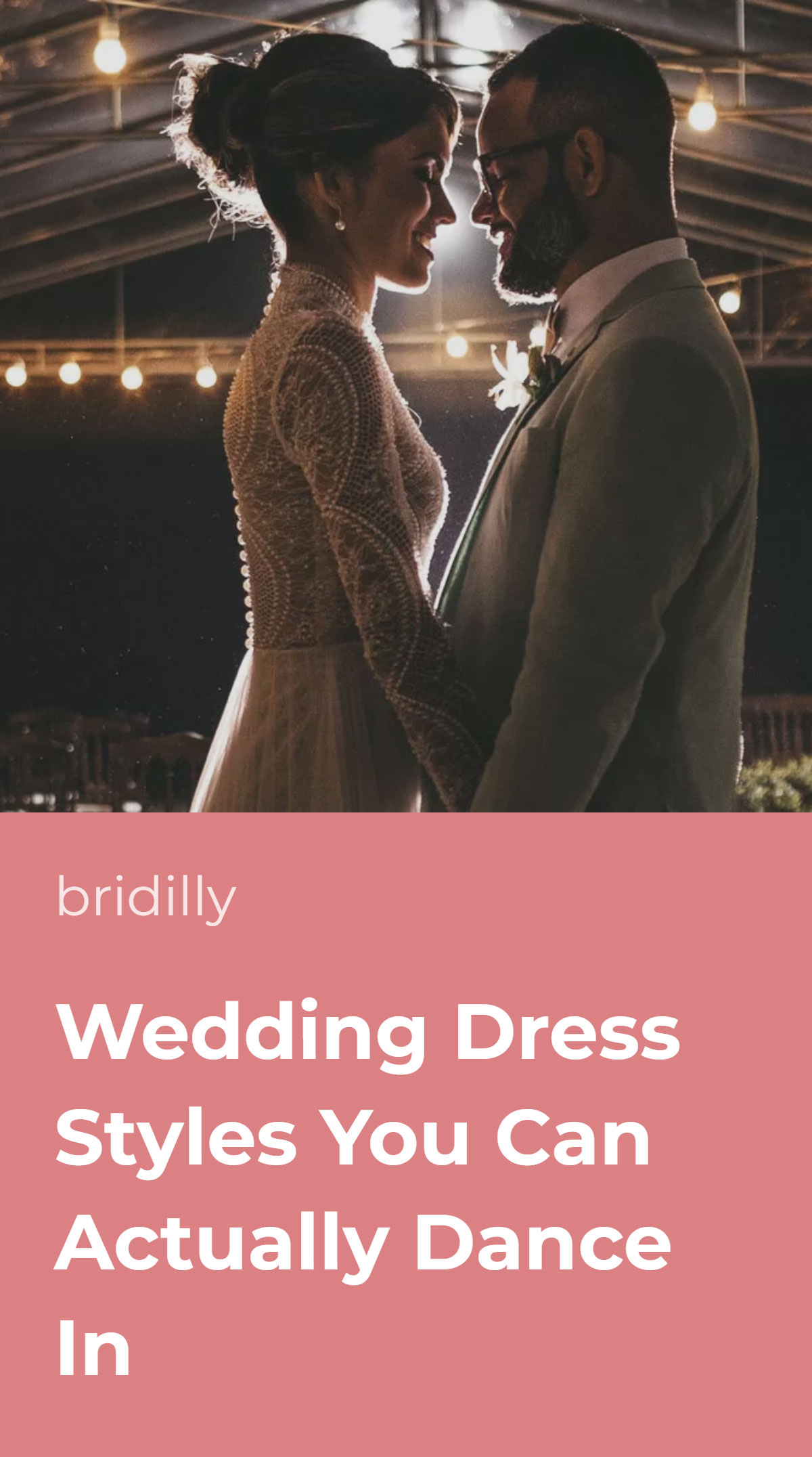Are you planning to rock the dance floor for your entire wedding night? Then you need a wedding dress you can dance in freely.
In an ideal world, you wouldn’t have to compromise comfort for the looks, but we don’t live in a fairytale.
The short note for buying a wedding dress for dancing includes only four critical tips: no tight corsets, no strapless styles, no overly fitted or overly puffy skirts, and no long trains.
The best wedding dress for dancing ideas include high-low and tea-length hemlines, slits, and traditional A-line silhouettes. Alternatively, you may get a short second wedding dress for ultimate party mode.
If you still wish to ditch the sophisticated extra-fitted look and don’t want a second dress, remember that practice is key to success. Any dress is a perfect wedding dress for dancing if you know how to dance.
Table of Contents [show]
Voluminous High-Low Dress
Puffy ball gowns are undoubtedly gorgeous and can have a jaw-dropping effect if styled correctly, but it’s one of the least comfortable wedding dress styles to dance in. You’ll spend the day constantly stepping on the skirt.
Furthermore, this skirt style creates much space between you and your partner, which doesn’t help in dancing. But if you truly admire voluminous skirts, consider getting a high-low wedding dress instead.
A high-low dress with a tight bodice and voluminous skirt will enhance the waist just as great as a ball gown, but you won’t step on it since the skirt is shorter from the front. Not all high-low dresses are the same, though.
You can choose a dress with a floor-length back that will resemble a ball gown and over-the-knee-length front for a modern, dramatic look or a calf-length back and knee-length front for a more modest appearance.
Tea-Length Dress
Tea-length wedding dresses are largely underestimated. This classical style from the 1950s’ is ideal for a retro-themed wedding but can look equally great in contemporary looks depending on the styling.
Tea-length dresses have voluminous A-line or ball gown-style skirts of calf-length or slightly shorter.
Styles with three-quarter or cap sleeves and high necklines carry romantic vintage aesthetics, whereas off-shoulder and strapless corset designs have a trendy look.
This wedding dress style is just as flowy and whimsical as traditional princess gowns but doesn’t prevent you from moving freely. Furthermore, it allows you to showcase your new heels – why hide them under a long skirt?
Overall, tea-length wedding dresses will best suit carefree, romantic, and modest brides who admire the 1950s’ style. They go perfectly with cat heels, intricate up-dos, and red lip makeup.
Classic A-Line Dress
The classic A-line silhouette is the most comfortable to dance in among all floor-length dresses. This dress silhouette typically has a fitted bodice with a natural waist and skirt that flares gradually on the sides.
A-line is one of the most popular wedding dress silhouettes for a good reason. Firstly, it looks flattering on all body types, be it pear, apple, or inverted triangle.
An A-line dress won’t make you a body you never had but will enhance your natural curves and conceal imperfections.
Secondly, A-line dresses feature a stunning princess-style skirt but aren’t as voluminous as ball gowns, allowing you to get close to your partner.
The skirt fabric is usually light, flowy, and soft, so you can easily move around.
Short Fringed Dress
Over-the-knee dresses may not be formal enough for a wedding ceremony, but if you’re considering getting a second wedding dress for dancing, this may be a perfect choice. Fringes will help to bring in the party atmosphere.
Fringed dresses were popular in the 1920s’, when they were worn by flappers – young women embracing fun and hedonistic lifestyle.
A century later, fringes returned to the fashion stage and are experiencing a real renaissance.
Perhaps, a short fringed dress is the most playful second wedding dress option of all.
The fringes can be made from feathers, fabric, or beads – but most importantly, they should swing as you move, attracting attention and encouraging others to join the dancefloor.
Choose traditional bridal colors: white, ivory, or champagne to distinguish your wedding dress from a regular party dress. The accessories and dress embellishments can be silver, gold, or rose gold, and the shinier, the better.
Dress With a Slit
A slit is a seemingly minor detail that can significantly impact your look and comfort. It allows you to move freely even in the longest and tightest skirt and adds a seductive appeal even to the most modest dresses.
A high-neck wedding dress with slit toes that narrow line between traditional and playful, sophisticated and sexy.
It allows you to look formal enough on the ceremony but hit the dancefloor on the reception – draw inspiration from Chiara Ferragni’s bridal look.
Alternatively, you can choose a halter-neck slip dress with a high slit as your second wedding dress, as seen on Hailey Bieber. Rich shades of gold, champagne, or subtle ivory and blush look even better with such styles than white.
Lightweight Fabrics
Even short wedding dresses can be hard to move and breathe in if made from heavy fabrics or feature large embellishments. Furthermore, heavy dresses tend to slip down. Choose lightweight and breathable fabrics over thick synthetics.
Synthetic gowns tend to be cheaper, and sometimes, you just can’t help but fall in love with a gorgeous dress made from pure polyester.
However, if you decide to wear such a gown for the ceremony, consider getting a second wedding dress for dancing.
Some of the best wedding dress fabrics are batiste, brocade, charmeuse, chiffon, crepe, dupioni, silk, georgette, organza, and cotton lace. These are natural fabrics that won’t make you perspire and won’t make your dress too heavy.
As for decorations, avoid heavy bead embellishments, opaque embroidery, and appliques on the skirt. Instead, look for dresses adorned with tiny crystals, lightweight lace, or sequins that allow the skirt to flow nicely.
No To Corsets
A corset can be a life-saving option for brides wishing to smooth their silhouette. It can give you a figure you never even dreamt of having and guarantee you perfect pictures without any photoshop.
However, corseted wedding gowns have a large drawback – they are extremely uncomfortable. Sure, a corset will help you keep the posture during a ceremony, but by the time everyone starts dancing, you’ll likely start to swell and sweat.
Corsets can significantly restrict movement and be difficult to breathe in.
Get some good shapewear instead if you’d like to smooth the body and provide extra bust support. And if you love corset backs, google “fake corset back wedding dress.”
Forget About Mermaid Silhouette
Mermaid wedding dresses are an extravagant and romantic style that can look breathtakingly beautiful on brides with curves. But it’s the absolute worst wedding dress style for dancing.
Mermaid wedding dresses are very restrictive, cinching the knees and hips and not allowing you to take a step. And if the dress has a train, it transforms into a real dancefloor hazard for you and everyone around you.
If that’s not a sufficient reason to forget about mermaid wedding dresses for dancing, many of them have corseted bodices or strapless sweetheart necklines.
They must be constantly adjusted and can be very tight – but hey, beauty requires sacrifices.
In short, a mermaid silhouette is an excellent option for a ceremony or brides who aren’t planning to dance. Everyone else should consider a different style for the reception.
Bustle The Train
Wedding gown trains can be very long. Some brides believe that the longer, the better, but that’s only true when you walk down the aisle while the train bearer holds it.
As soon as the ceremony is over, you’ll want to tuck it somewhere to walk freely.
However, there’s no need to get a second wedding dress or deny the train entirely. You can add a train loop to your wedding dress back that will lift the train from the ground and make your skirt look even fuller from the back.
Alternatively, you may attach a wrist loop to the train. This creative and romantic yet highly practical detail can serve as a bracelet and make each arm movement even more graceful.
Some wedding dresses also feature detachable trains. They usually attach around the waist to create a ballgown effect and may hide a shorter dress for dancing underneath.
Practice Makes Perfect
At the end of the day, some women get married in extremely tight and uncomfortable dresses and still manage to dance. When you’re happy, you don’t really care about stepping on the skirt or feeling a bit hot.
You can and should practice dancing in your wedding dress before the event. None of us walks in a heavy floor-length gown with a corset and on high heels on a daily basis, so not feeling confident at first is normal.
Each dress is different, and you can learn to move in any if you spend enough time in it. For instance, a mermaid dress won’t allow you to dance tango or waltz but is well-suitable for rumba where leg movements are small.
Get in your heels and learn to walk in the dress. Then, you can move on to practicing dance moves – you can even enroll in dance lessons, but don’t attend them in a wedding dress… unless they are private wedding dance lessons!




















No Comments Add one
Leave a Comment